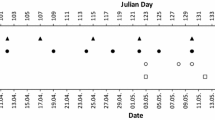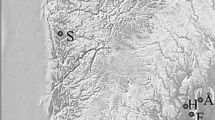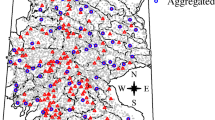Abstract
A considerable number of studies have investigated the phenology of European beech using models, experimental controlled conditions, or descriptive surveys of patterns in situ. In spite of this interest, there is no consensus about the environmental factors controlling bud burst in beech, especially about the role of photoperiod and chilling temperature (cold temperature effective to release bud dormancy). However, recent experimental and modelling studies provide new insights into the means by which these environmental factors control beech phenology. This present contribution aims to reconcile contradictory hypotheses about the main environmental factors controlling bud burst date of European beech. First, we review the main published results on the environmental control of beech phenology both in controlled and in natural conditions. Second, supported by the findings of recent studies, we propose a new theory for the role of photoperiod during the chilling phase for explaining spatial and temporal variations in bud burst phenology of European beech. Examples using long-term data from the Swiss Alps and Germany are presented to support this theory. The possible impacts of future and ongoing climate warming on beech phenology are discussed. Finally, due to interactions between chilling, forcing temperature, and photoperiod, we assert that beech phenology follows a nonlinear trend across biogeographical gradients such as changes in elevation or latitude and that the bud burst date of beech is expected not to undergo significant changes in response to global warming, especially in warmer climates.




Similar content being viewed by others

References
Basler D, Körner C (2012) Photoperiod sensitivity of bud burst in 14 temperate forest tree species. Agric For Meteorol 165:73–81
Bertin RI (2008) Plant phenology and distribution in relation to recent climate change. J Torrey Bot Soc 135(1):126–146
Bolte A, Czajkowski T, Kompa T (2007) The north-eastern distribution range of European beech—a review. Forestry 80(4):413–429
Caffarra A, Donnelly A (2011) The ecological significance of phenology in four different tree species: effects of light and temperature on bud burst. Int J Biometeorol 55(5):711–721
Caffarra A, Donnelly A, Chuine I, Jones MB (2011) Modelling the timing of Betula pubescens budburst. I. Temperature and photoperiod: a conceptual model. Clim Res 46(2):147–157
Cannell MGR, Smith RI (1983) Thermal time, chill days and prediction of budburst in Picea sitchensis. J Appl Ecol 20(3):951–963
Chuine I (2000) A unified model for budburst of trees. J Theor Biol 207(3):337–347
Chuine I (2010) Why does phenology drive species distribution? Philos Trans R Soc B Biol Sci 365(1555):3149–3160
Churkina G, Schimel D, Braswell BH, Xiao XM (2005) Spatial analysis of growing season length control over net ecosystem exchange. Glob Change Biol 11(10):1777–1787
Cooke JEK, Eriksson ME, Junttila O (2012) The dynamic nature of bud dormancy in trees: environmental control and molecular mechanisms. Plant, Cell Environ. doi:10.1111/j.1365-3040.2012.02552.x
Cufar K, De Luis M, Saz MA, Crepinsek Z, Kajfez-Bogataj L (2012) Temporal shifts in leaf phenology of beech (Fagus sylvatica) depend on elevation. Trees 26(4):1091–1100
Davi H, Gillmann T, Cailleret M, Bontemps A, Fady B, Lefèvre F (2011) Diversity of leaf unfolding dynamics among tree species: new insights from a study along an altitudinal gradient. Agric For Meteorol 151(12):1504–1513
Dittmar C, Elling W (2006) Phenological phases of common beech (Fagus sylvatica L.) and their dependence on region and altitude in Southern Germany. Eur J For Res 125(2):181–188
Falusi M, Calamassi R (1990) Bud dormancy in beech (Fagus sylvatica L.). Effect of chilling and photoperiod on dormancy release of beech seedlings. Tree Physiol 6(4):429–438
Falusi M, Calamassi R (1996) Geographic variation and bud dormancy in beech seedlings (Fagus sylvatica L). Ann Sci For 53(5):967–979
Falusi M, Calamassi R (2003) Dormancy of Fagus sylvatica L. buds III. Temperature and hormones in the evolution of dormancy in one-node cuttings. Plant Biosyst 137(2):185–191
Gomory D, Paule L (2011) Trade-off between height growth and spring flushing in common beech (Fagus sylvatica L.). Ann For Sci 68(5):975–984
Gordo O, Sanz JJ (2009) Long-term temporal changes of plant phenology in the Western Mediterranean. Glob Change Biol 15(8):1930–1948
Gu L, Hanson PJ, Mac Post W, Kaiser DP, Yang B, Nemani R, Pallardy SG, Meyers T (2008) The 2007 eastern US spring freezes: increased cold damage in a warming world? Bioscience 58(3):253–262
Hänninen H, Kramer K (2007) A framework for modelling the annual cycle of trees in boreal and temperate regions. Silva Fennica 41(1):167–205
Harrington CA, Gould PJ, St Clair JB (2010) Modeling the effects of winter environment on dormancy release of Douglas-fir. For Ecol Manage 259(4):798–808
Heide OM (1993) Dormancy release in beech buds (Fagus sylvatica) requires both chilling and long days. Physiol Plant 89(1):187–191
Hunter AF, Lechowicz MJ (1992) Predicting the time of budburst in temperate trees. J Appl Ecol 29(3):597–604
Jochner S, Sparks T, Estrella N, Menzel A (2012) The influence of altitude and urbanisation on trends and mean dates in phenology (1980–2009). Int J Biometeorol 56:387–394
Körner C, Basler D (2010) Phenology under global warming. Science 327(5972):1461–1462
Kramer K (1994) Selecting a model to predict the onset of growth of Fagus sylvatica. J Appl Ecol 31(1):172–181
Kramer K (1995) Phenotypic plasticity of the phenology of seven European tree species in relation to climatic warming. Plant, Cell Environ 18(2):93–104
Kreyling J, Thiel D, Nagy L, Jentsch A, Huber G, Konnert M, Beierkuhnlein C (2012) Late frost sensitivity of juvenile Fagus sylvatica L. differs between southern Germany and Bulgaria and depends on preceding air temperature. Eur J For Res 131(3):717–725
Lang GA, Early JD, Martin GC, Darnell RL (1987) Endo-, para-, and ecodormancy: physiological terminology and classification for dormancy research. HortScience 22(3):371–377
Lebourgeois F, Pierrat JC, Perez V, Piedallu C, Cecchini S, Ulrich E (2010) Simulating phenological shifts in French temperate forests under two climatic change scenarios and four driving global circulation models. Int J Biometeorol 54(5):563–581
Menzel A, Estrella N, Fabian P (2001) Spatial and temporal variability of the phenological seasons in Germany from 1951 to1996. Glob Change Biol 7(6):657–666
Migliavacca M, Cremonese E, Colombo R, Busetto L, Galvagno M, Ganis L, Meroni M, Pari E, Rossini M, Siniscalco C, di Cella UM (2008) European larch phenology in the Alps: can we grasp the role of ecological factors by combining field observations and inverse modelling? Int J Biometeorol 52(7):587–605
Murray MB, Cannell MGR, Smith RI (1989) Date of budburst of fifteen tree species in Britain following climatic warming. J Appl Ecol 26(2):693–700
Myking T, Heide OM (1995) Dormancy release and chilling requirement of buds of latitudinal ecotypes of Betula pendula and B. pubescens. Tree Physiol 15(11):697–704
Polgar CA, Primack RB (2011) Leaf-out phenology of temperate woody plants: from trees to ecosystems. New Phytol 191(4):926–941
Rötzer T, Grote R, Pretzsch H (2004) The timing of bud burst and its effect on tree growth. Int J Biometeorol 48(3):109–118
Schaber J, Badeck FW (2003) Physiology-based phenology models for forest tree species in Germany. Int J Biometeorol 47(4):193–201
Studer S, Appenzeller C, Defila C (2005) Inter-annual variability and decadal trends in alpine spring phenology: a multivariate analysis approach. Clim Change 73(3):395–414
Thompson R, Clark RM (2008) Is spring starting earlier? Holocene 18(1):95–104
Thornton PE, Running SW, White MA (1997) Generating surfaces of daily meteorological variables over large regions of complex terrain. J Hydrol 190(3–4):214–251
Vitasse Y, Delzon S, Dufrene E, Pontailler JY, Louvet JM, Kremer A, Michalet R (2009a) Leaf phenology sensitivity to temperature in European trees: do within-species populations exhibit similar responses? Agric For Meteorol 149(5):735–744
Vitasse Y, Porte AJ, Kremer A, Michalet R, Delzon S (2009b) Responses of canopy duration to temperature changes in four temperate tree species: relative contributions of spring and autumn leaf phenology. Oecologia 161(1):187–198
Vitasse Y, Francois C, Delpierre N, Dufrene E, Kremer A, Chuine I, Delzon S (2011) Assessing the effects of climate change on the phenology of European temperate trees. Agric For Meteorol 151(7):969–980
Wareing PF (1953) Growth studies in woody species. V. Photoperiodism in dormant buds of Fagus sylvatica. Physiol Plant 6(4):692–706
Acknowledgments
We are grateful to Thomas Herren for providing the phenological data of European beech from the MeteoSwiss (Swiss Federal Office of Meteorology and Climatology) and the Landscape dynamic unit, Swiss Federal Institute for Forest, Snow and Landscape Research, WSL, Birmensdorf, Switzerland for providing the modelled temperature data used in the Fig. 3. We thank Wade Jenner for linguistic revision and improvement of the text. We are grateful to two anonymous referees and for their valuable comments on a previous version of the manuscript. The research has been funded by the European Research Council (ERC) grant 233399 (project TREELIM).
Author information
Authors and Affiliations
Corresponding author
Additional information
Communicated by Uta Berger.
Rights and permissions
About this article
Cite this article
Vitasse, Y., Basler, D. What role for photoperiod in the bud burst phenology of European beech. Eur J Forest Res 132, 1–8 (2013). https://doi.org/10.1007/s10342-012-0661-2
Received:
Revised:
Accepted:
Published:
Issue Date:
DOI: https://doi.org/10.1007/s10342-012-0661-2



